Blog
Almond & Ada: privacy-focused voice assistant
TL;DR:
- Teamed up with Almond
, available in Home Assistant 0.102. - Introducing Ada
, voice assistant powered by Home Assistant integrations. Available as Hass.io add-on. - New beta speech-to-text and text-to-speech service for Home Assistant Cloud subscribers.
Voice assistants are a great way to interact with your house, ask a quick question, set a timer or control your devices. The more an assistant knows about you, your home and its other inhabitants, the better it is able to help you.
Today’s available virtual assistants work great, but they have a big problem: They store your data in the cloud, don’t provide APIs to allow other companies to build products on top and are run by companies whose core business is building profiles on their users to help serve ads and product suggestions.
The backbone to our homes needs to be one that keeps data local and has APIs allowing other companies to build on top. Innovation happens when many different people, with many different backgrounds, do many different experiments until we find something that sticks. This cannot be left to a single company.
Recently we got in touch with the Open Virtual Assistant Lab at Stanford University
0.102: Official Android App, Almond, Scene editor
Home Assistant 0.102 is here ! It’s been quite the trip as we hosted our annual State of the Union last week, which took a lot of energy away from our release. This doesn’t mean that we don’t have anything to share, just that the notes might be a little less polished.
First, we had our State of the Union at the ING office in Amsterdam! It was great. You can watch it back on YouTube
Alright, so what’s new? A lot.
Android App released!
At the State of the Union we announced that we have released the initial version of the official Home Assistant Android app
It’s been developed by @CedrickFlocon
0.101: Airly, Apprise, Sinch, Solar-Log, Microsoft Teams
Hacktoberfest
It is almost the end of Hacktoberfest, and boy, it was a good one. We had a total of 1318 PRs merged in the last month. And most of them are in this release!
We had: 154 authors on home-assistant 184 authors on home-assistant.io 30 authors on home-assistant-polymer
A lot of thanks to all the contributors!
API Password and trusted networks
It is no longer possible to make authenticated requests using trusted networks or by appending ?api_password=X to the URL. You will now first need to get an authentication token and use that token to make requests.
These features were deprecated in Home Assistant 0.90 and 0.91 (released around April 2019). It was initially planned to be dropped in Home Assistant 0.96 (released July 17, 2019).
The support of configuring the auth providers for API Password and Trusted Networks via the HTTP configuration is also removed. It now needs to be configured in the auth provider section (docs).
Direct authentication meant that you could make an authenticated request without a bearer token by making the request from a trusted network or appending ?api_password=X to the URL.
These features are still available as authentication providers (docs).
You can use Long-Lived Access Tokens that can be created in the fronted on your profile page. These tokens will not expire and can be added in the header of the request. See the developer documentation for more info.
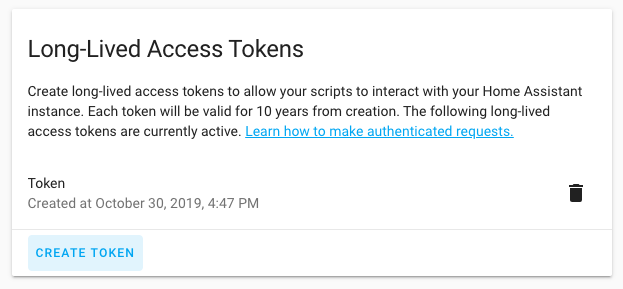 Screenshot of the Long-Lived Access Tokens interface in the profile page.
Screenshot of the Long-Lived Access Tokens interface in the profile page.
Or you can use a webhook-based-integration. A webhook is a unique hard to guess URL that can be used to send data to Home Assistant. Requests made to webhooks do not need authentication. Your webhook should be available from the internet, if you have a cloud subscription, the cloud will take care if this. You can find the cloud webhook URLs on your cloud configuration page.
Hassbian
As you may have already read, we’ll be sunsetting Hassbian.
Hassbian was a superset of Raspbian optimized for Home Assistant. With limited time from the developers and easier alternatives as Hass.io it is time to sunset Hassbian.
A big thank you to all those who worked on Hassbian - specifically @landrash
For more info, read the blogpost
Device automations
This release includes improved support for alarms, covers, locks and sensors. A “for” option was added in release 0.100 which allows you to specify triggers for when a certain device has been in a certain state for a period of time, in this release we added support for it in the automation editor.
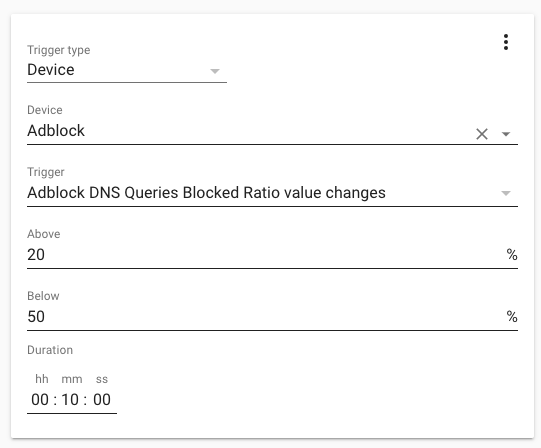 Screenshot of a device trigger with duration.
Screenshot of a device trigger with duration.
Frontend
A lot has happened on the frontend; we had a ton of Hacktoberfest PRs that added localization to the frontend and made our user experience better.
A special shout out to @springstan
Thanks a lot to all the contributors!
We now have our own confirmation dialogs thanks to @timmo001
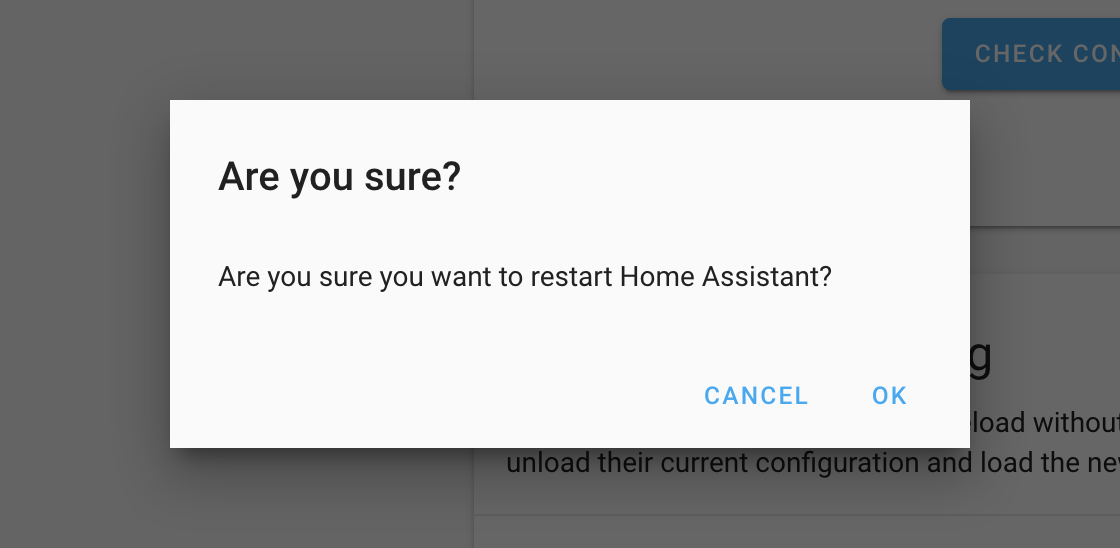 Screenshot of a confirm dialog when restarting Home Assistant.
Screenshot of a confirm dialog when restarting Home Assistant.
In the last release, we changed all the JSON inputs to YAML inputs, this release we add a code editor to all the YAML and Jinja2 inputs. This makes it a lot easier to read and write YAML.
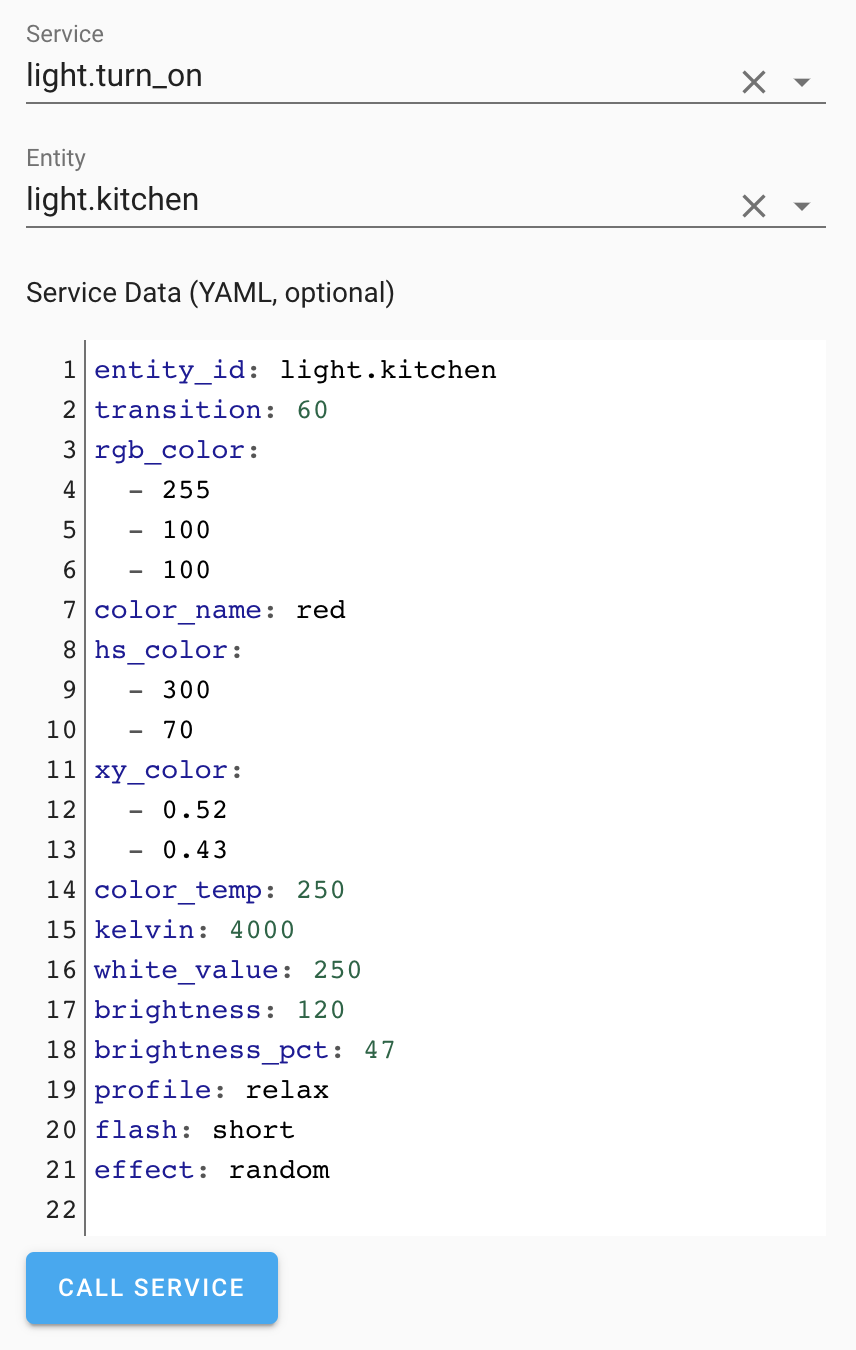 Screenshot of the service dev tools with YAML editor.
Screenshot of the service dev tools with YAML editor.
The entity registry is now also migrated to a datatable so you can easily search and sort your entities so it is easier to find the one you are looking for.
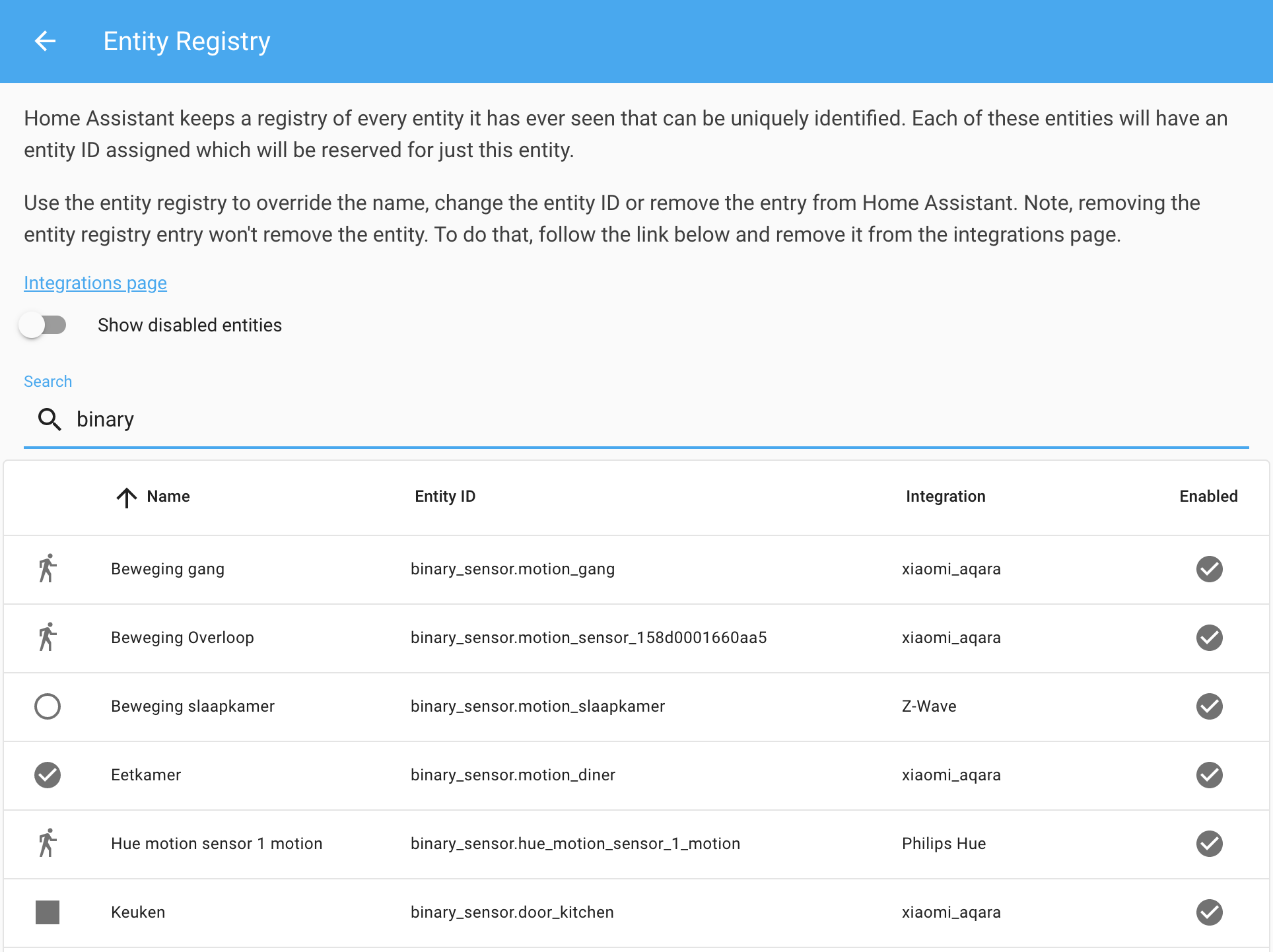 Screenshot of the entity registry data table.
Screenshot of the entity registry data table.
We improved the device picker in automations, you can now search them and see in what area the device is.
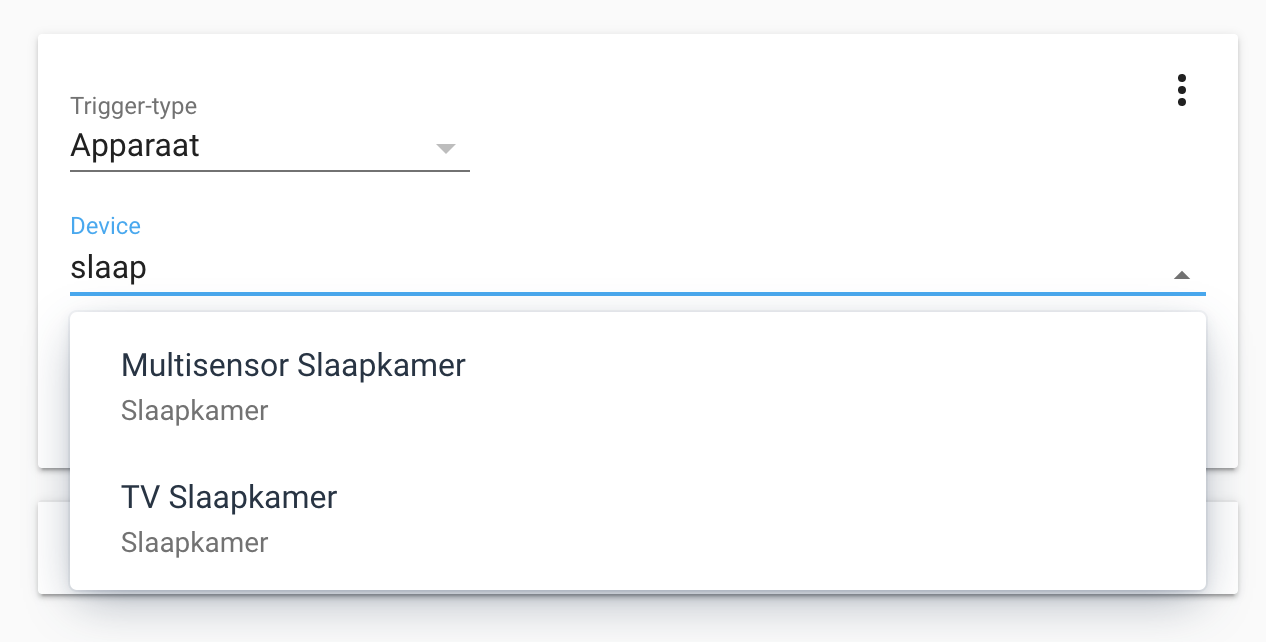 Screenshot of the device picker.
Screenshot of the device picker.
mdonoughe
Lovelace
Check the Lovelace changelog for all changes.
In other news
Proud to announce that the Visual Studio Code add-on for @home_assistant
— Franck Nijhof (@Frenck) October 26, 2019reached v1.0.0! 🎉
This version ships the second generation code-server, VSCode 1.39, HA extension 1.3, updates MDI ext and adds a rainbow indent function ❤️
Oh, and it is FAST 🚀 pic.twitter.com/eBe8CirZ4B
It is done! Making magic with #python
— Esther Makes Tech (@esthermakestech) October 19, 2019#opencv #tensorflow #homeassistant . https://t.co/ZiN5AE7ixt
Weekend IOT project: Weather info from the Cloud, literally. Details on github here:https://t.co/V9xpxqyRAv
— Gabe Scelta (@sfgabe) October 14, 2019#homeassistant #arduino #mqtt #smarthome pic.twitter.com/YrkEBpa9Rw
🎉Restriction Card for @home_assistant
— Ian Richardson (@iantrich) October 17, 2019released 🎉
Client-side security for your Lovelace cards
* Options to hide/block/lock/password-protect/confirm interactions with cards
* Set conditions for when to apply
* Set exemptions based on usershttps://t.co/psiVBf9U7N
New Integrations
- Add Airly integration (@bieniu
- #26375 ) (airly docs) (new-integration) - Add Apprise notification integration (@caronc
- #26868 ) (apprise docs) (new-integration) - New sensor platform integration for Orange and Rockland Utility smart energy meter (@bvlaicu
- #27571 ) (oru docs) (new-integration) - Add sinch integration (notify component) (@bendikrb
- #26502 ) (sinch docs) (new-integration) - Add Solar-Log platform ([@Ernst79] - #27036
) (solarlog docs) (new-integration) - New platform for Microsoft Teams (@peroyvind
- #27981 ) (msteams docs) (new-integration)
New Platforms
- UniFi - Bandwidth sensors ([@Kane610] - #27229
) (unifi docs) (breaking change) (new-platform) - Neato battery sensor (@dshokouhi
- #27286 ) (neato docs) (new-platform) - Add sensor platform to Airly integration (@bieniu
- #27717 ) (airly docs) (new-platform) - Move imports in mqtt component (@exxamalte
- #27835 ) (mqtt docs) (new-platform)
Release 0.101.1 - October 31
- Bump songpal to fix a regression (@rytilahti
- #28115 ) (songpal docs) - Bump pymyq to 2.0.1 (@bachya
- #28348 ) (myq docs) - Bump pysaj to v0.0.13 (fix for sensor date) (@fredericvl
- #28351 ) (saj docs) - Bump env_canada to fixed 0.0.29 version (@shmick
- #28360 ) (environment_canada docs) - Fix Airly asyncio timeout error (@bieniu
- #28387 ) (airly docs) - Fix hdate spamming homeassistant log (@tsvi
- #28392 ) (jewish_calendar docs) - Fix check config (@balloob
- #28393 ) - Check for import errors before validating config (@balloob
- #28395 )
Release 0.101.2 - November 1
- Prevent TypeError when KNX RGB(W) light value contains None (@phispi
- #28358 ) (knx docs) - Change Abode cache file path, add cache path to config flow (@MisterWil
- #28389 ) (abode docs) - SNMP switch fix integer support (@rfpronk
- #28425 ) (snmp docs) - Use server-specific unique_ids for Plex media_players (@jjlawren
- #28447 ) (plex docs) - Also install after_deps (@balloob
- #28453 )
Release 0.101.3 - November 5
- Fix missing import (@timmccor
- #28460 ) (sonos docs) - Fix Airly if more than one config entry (@bieniu
- #28498 ) (airly docs) - Add deprecated attributes to light.reproduce_state (@Santobert
- #28557 ) (light docs)
If you need help…
…don’t hesitate to use our very active forums or join us for a little chat
Reporting Issues
Experiencing issues introduced by this release? Please report them in our issue tracker
R.I.P Hassbian
It’s time for what was once the simplest way to install Home Assistant to retire.
R.I.P Hassbian
Some of you will probably wonder why Hassbian is being retired and I’ll try to give a proper motivation.
First of is the age-old factor of time. I as the lead developer of Hassbian haven’t been able to give it the time and attention it requires, and there have been few others that have pushed the project further. The one exception being @ludeeus
Next Step for Hassbian
Since Hassbian has been around for quite a while, there are quite a few users that don’t want Hassbian to go away. To make this as easy as possible for those users, here’s the plan.
- The repositories pi-gen
and hassbian-scripts hosting the Hassbian projects files will be moved to a new organization. - A last release will be done by me mid Q4 2019. This image will be hosted under the pi-gen
repository. - The pi-gen
repository will be reworked to work with a standard raspbian image with minor modifications for anyone wanting to create their own “Hassbian like” image. This has always been possible, but the current repository is a bit out of date with the current layout of the Raspbian image. - The hassbian-scripts
package will get a final release and will continue to be hosted on Gitlab. Some minor changes will be made to reflect the changes to the project.
Next step for Hassbian users
The Hassbian image has always aimed to be the same as a manual Raspbian Lite installation with some packages added. There won’t really be any big changes for all of the users of Hassbian and for documentation, please refer to the Manual installation on a Raspberry PI method.
Alternatives
If you want to continue using something similar, have a look at the manual installation on a Raspberry Pi since it is the base Hassbian was created from. For everyone else, I would wholeheartedly recommend Hass.io since it is what I personally use now (It’s what I had hoped Hassbian could have been but better).
Last but not least
Last but not least, thank you to all of those who contributed, in any way, to the Hassbian project and image.
0.100: Better Plex, Bye JSON, HERE Travel time.
Welcome to the release notes of yet another wonderful release! No, we’re not going for 1.0, we’re doing 0.100! We feel like we’re not ready yet with our goals for 1.0, but we’re making progress every day. For a sneak peak of what we’re thinking about, check our blog Simple mode in Home Assistant 1.0.
Hacktoberfest
It is Hacktoberfest. This means that we’re spending the month celebrating contributing to open source. If you make 4 pull requests this month, you get a free Hacktoberfest t-shirt! More info and what to work on, check our Hacktoberfest blog post.
Average contributions per day have doubled for the month of October. There are now on average 40 contributions coming in each day. Breakdown is ~50% Home Assistant backend, ~37% documentation and ~13% the frontend. Most of these contributions you’ll see in the next release!
 Last 14 days of pull pequest throughput in the Home Assistant organization. (source
Last 14 days of pull pequest throughput in the Home Assistant organization. (source
State of the Union 2019
We’re going to have another State of the Union! It will be held at November 13, in Amsterdam. Like last year, it will be hosted by our friends at ING. I’m looking forward to talk about all the great things that are happening in Home Assistant land. We had 150 tickets available when we announced it on social media, and they were all gone in less than 24 hours!
We’re going to make sure that there will be a live stream available. We’ll announce that in time via the blog and social media. Some people are talking about hosting viewing parties across the globe. Keep an eye out on the social category on the forums for announcements. This would also be the place to announce if you are planning on hosting one.
Plex
@jjlawren
 Screenshot of the Plex user interface asking the user if they want to link with Home Assistant.
Screenshot of the Plex user interface asking the user if they want to link with Home Assistant.
Lovelace
@iantrich
- There are a lot more option for state filtering
- We have a bunch of new UI editors
- A new action
urlto link to external sites - Config panel: Disabled entities are now hidden by default.
Device automations
@emontnemery
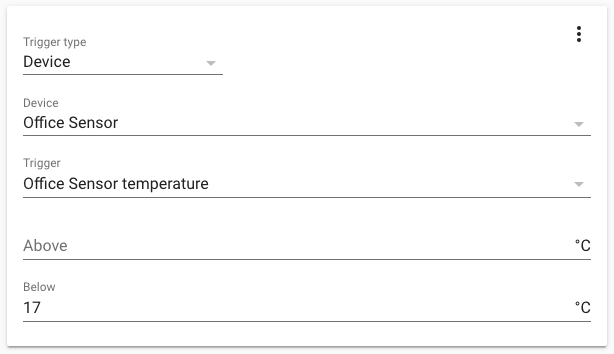 Screenshot of a device trigger for a temperature sensor.
Screenshot of a device trigger for a temperature sensor.
Automation editor
@emontnemeryand and or conditions, and give your automation a description so you know why you did what you did.
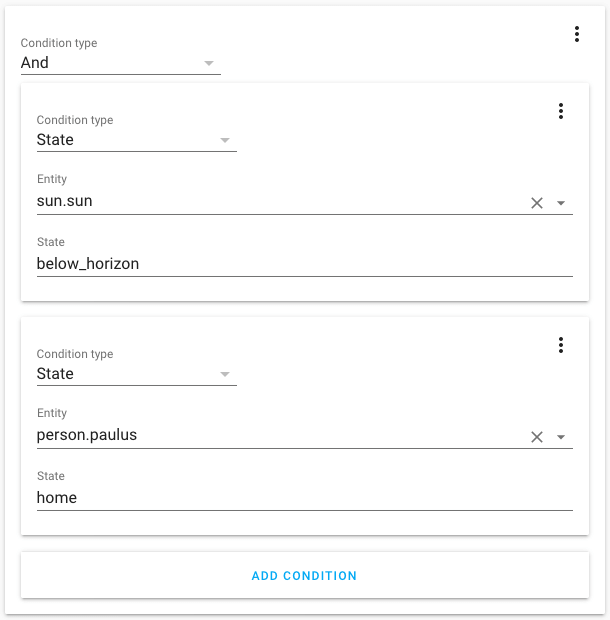 Screenshot of an and-condition in the automation editor.
Screenshot of an and-condition in the automation editor.
Devices
Device automations are now available on the experimental device page that we introduced in the last release. You can now see all the triggers, conditions and actions the device supports. Clicking on it will open the automation editor with the automation filled in, ready to edit.
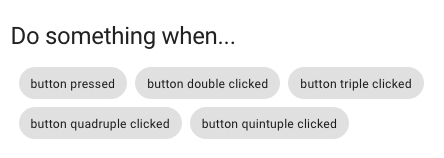
We also added the entity registry, so you can change all the settings of the devices entities in one place.
And, bonus, when you rename a device on the device page, it will now also rename the entities of that device if they contain the device name. When you are in advanced mode, it can also rename the entity id’s for you.
Goodbye JSON 👋
On the backend we have been using YAML for a long time, but on the frontend, we still used JSON for a lot of things. JSON is harder to write than YAML so we have aligned that. All data inputs on the frontend now accept YAML. You can still use JSON, as JSON is valid YAML.
This includes:
- The automation editor
- The script editor
- Services data in dev tools
- States in dev tools
- Events in dev tools
 Screenshot of a service action in the automation editor using YAML.
Screenshot of a service action in the automation editor using YAML.
Thank You, @Amelchio
Core developer @amelchio
Thanks Anders, we’re going to miss you! ❤️
In other news
Hans Oischinger showcased how he can steer his vacuum cleaner to specific rooms in his house via his floorplan. Besides this tweet, he also wrote a great blog about it
Freed my vacuum robot from the cloud with https://t.co/tirC2vcsqK
— Hans Oischinger (@oischinger) September 29, 2019
This unlocked some new functionality for my vacuum:
Configure and start zoned cleanup in @home_assistantwith live map overlayed on the floorplan pic.twitter.com/jtPZHk2xeT
To improve discovery, we’re collecting discovery info of devices and services. Please help us gather zeroconf discovery info
As always, this release of Home Assistant is accompanied with a new release of the Home Assistant Podcast
Time for another #smarthome
— Phil Hawthorne (@philhawthorne) October 9, 2019#Podcast
This week we're talking @home_assistantversion 1...hundred, @hacktoberfest and catch up with 🇦🇺 Tony about his #homeautomation journey with Home Assistant, or maybe it should just be @NodeRED 🤷♂️https://t.co/DUtNZTHOAA
New Integrations
- Add support for DOODS Image Processing (@snowzach
- #26208 ) (doods docs) (new-integration) - Izone component ([@Swamp-Ig] - #24550
) (izone docs) (new-integration) - Add transport data from maps.yandex.ru api (@rishatik92
- #26252 ) (yandex_transport docs) (new-integration) - Add Kaiterra integration ([@Michsior14] - #26661
) (kaiterra docs) (new-integration) - Add Ombi integration (@larssont
- #26755 ) (ombi docs) (new-integration) - Add here_travel_time (@eifinger
- #24603 ) (here_travel_time docs) (new-integration) - Add support for SOMA Smartshades devices (@ratsept
- #26226 ) (soma docs) (new-integration) - Add saj component (@fredericvl
- #26902 ) (saj docs) (new-integration)
New Platforms
- Add iaqualink binary sensor and unique_id (@flz
- #26616 ) (iaqualink docs) (new-platform) - Add basic support for IKEA Fyrtur blinds (@ggravlingen
- #26659 ) (tradfri docs) (new-platform) - Centralize rainbird config and add binary sensor platform (@konikvranik
- #26393 ) (rainbird docs) (breaking change) (new-platform)
Release 0.100.1 - October 10
- Fix build not succeeding @bramkragten
Release 0.100.2 - October 12
- Vangorra withings fix (@vangorra
- #27404 ) (withings docs) - Bump python-songpal (@rytilahti
- #27398 ) (songpal docs) - bump songpal to fix attrs usage when using its most recent version (@rytilahti
- #27410 ) (songpal docs) - iaqualink: set 5s timeout, use cookiejar defaults (@flz
- #27426 ) (iaqualink docs) - Add mobile_app dependency on cloud (@uSpike
- #27470 ) (mobile_app docs) - Fix for unknown sensor state (@marthoc
- #27542 ) (ecobee docs) - Google: catch query not supported (@balloob
- #27559 ) (google_assistant docs) - Fixing nzbget units display (@chriscla
- #27521 ) (nzbget docs)
Release 0.100.3 - October 21
- Use URI provided by Plex for local connections (@jjlawren
- #27515 ) (plex docs) - Update pymyq to 2.0.0 (@bachya
- #28069 ) (myq docs)
If you need help…
…don’t hesitate to use our very active forums or join us for a little chat
Reporting Issues
Experiencing issues introduced by this release? Please report them in our issue tracker
0.99: Withings, Device Automations, launch Home Assistant Cast from Python.
Happy 6th birthday to us! Yep, it’s been 6 years since the first commit, 6 years since we started our quest for a local and privacy foucsed home automation hub. And I think that we’re doing a pretty ok job 😏
It’s time for Home Assistant release 99. And this release is adding a bunch of new great features all over the place.
Welcome Bram!
Nabu Casa
This is possible thanks to all the people who subscribe to Home Assistant Cloud ❤️
Device Automations
We took a step back, looked at Home Assistant, and thought about how we could make it easier for users to create automations. We realized that there was room for improvement. We identified the following issues:
- To write automations, users need to learn Home Assistant concepts like events, entities and services.
- It’s difficult to discover what can be automated. For example, if you’re automating a long press on the “turn on” button on a Zigbee remote, you need to know to listen to the event “zha_event” and match against the Zigbee device identifier of your remote and the long press type.
So we put our inventor hat on and have come up with a solution that allows users to create automations in the concepts that they already know: devices. Now when a user starts configuring an automation trigger, it can pick device automation as a new type.
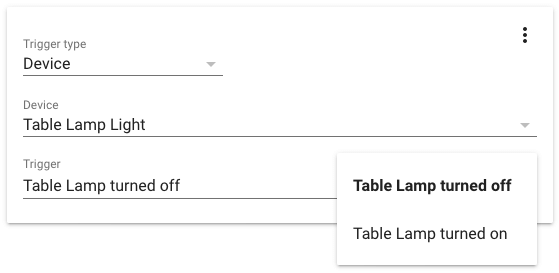 Screenshot of defining a device trigger in the UI.
Screenshot of defining a device trigger in the UI.
The user starts by picking one of their devices that is integrated into Home Assistant. A second dropdown will now appear that contains all the possible triggers for this device. This list is populated based on the integrations that are linked to this device (ie. Hue & Light).
Device automations are available for triggers, conditions and actions. Today’s release supports lights, switches and Deconz. More to come in future releases as integration developers adopt it.
Big thanks to @emontnemery
Frontend
There is a lot to talk here. Buckle up.
@thomasloven
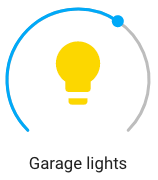
Shout out to @iantrich
Unused entities has been moved into the configure UI section and completely revamped by @bramkragten
 Screenshot of the new unused entities page.
Screenshot of the new unused entities page.
Now that we have a data table component, Bram also went ahead and used it in a new devices page. This page, still experimental, will allow users to see a list of all their devices and sort them by manufacturer, area or battery %. The goal is to create a one stop shop for device management.
 Screenshot of the new devices page.
Screenshot of the new devices page.
And there is a ton more, here are some of the other highlights:
- Allow subscribing to an MQTT topic inside the MQTT dev tools @bramkragten
- Option to display last changed in glance-card @iantrich
- Add image option to glance card entities @iantrich
- Allow controlling timer entities from the more info dialog @iantrich
- Fill example data in dev tools @bramkragten
- Stop effect in more-info-light @iantrich
- Add vibration on mobile when controlling entities @bramkragten
- Update Home Assistant logs when activating the info developer tool tab @bramkragten
Launch Home Assistant Cast from Python
Home Assistant now supports opening Home Assistant Cast from the backend. It is available as the service cast.show_lovelace_view. This allows you to open a view on your Chromecast as part of an automation. For example, show the frontdoor and who is home when your doorbell rings.
Note that Home Assistant Cast requires your Home Assistant installation to be accessible via https://. If you’re using Home Assistant Cloud, you don’t need to do anything. Otherwise you must make sure that you have configured the base_url for the http integration.
Hass.io
Hass.io is now able to work with your secrets stored in Home Assistant. So now you are able to use !secret my_value inside add-on options like you can do inside configuration.yaml. For more info about how to define secrets, check the docs.
We have published a release candidate of HassOS that is compatible with the new Raspberry Pi 4. Download it here
In other news
Home Assistant had a booth this year at the CEDIA home tech trade show
Hanging out at @CEDIAExpo
— Home Assistant (@home_assistant) September 13, 2019in innovation alley pic.twitter.com/9SnUXo11oA
We also had some great drinks in the evenings with companies that integrate with Home Assistant. In this picture Konnected.io and Senic.
Beers after CEDIA with @balloob
— Konnected.io (@Konnected_io) September 14, 2019from Home Assistant and teams from Senic and Neeo. pic.twitter.com/c6Ag4DeEtU
@timmo
It's finally here. 🎉
— Timmo (@timmo001) September 14, 2019
Home Panel v2.0.0 is now released and has been completely rewritten in #Reactwith #TypeScript
⚠️Please read the release notes before upgrading as are backward-incompatible changes to know about before upgrading!https://t.co/NMDQu4zZW8#HomePanel #HomeAssistant pic.twitter.com/ucA1HxwurB
New Integrations
- Add Withings support (@vangorra
- #25154 ) (withings docs) (new-integration) - Add NWS weather ([@MatthewFlamm] - #23647
) (nws docs) (new-integration) - Add BeeWi SmartClim BLE sensors (@alemuro
- #26174 ) (beewi_smartclim docs) (new-integration) - Add support Slide cover (@ualex73
- #25913 ) (slide docs) (new-integration) - Add atome sensor platform ([@BaQs] - #26197
) (atome docs) (new-integration) - Add Viessmann ViCare Climate platform (@oischinger
- #26151 ) (vicare docs) (new-integration) - Add new integration for Jandy iAqualink pool control (@flz
- #26034 ) (iaqualink docs) (new-integration) - Add vivotek camera component ([@HarlemSquirrel] - #26071
) (vivotek docs) (new-integration) - Add growatt server integration (@indykoning
- #25635 ) (growatt_server docs) (new-integration) - Add Obihai integration (@dshokouhi
- #26537 ) (obihai docs) (new-integration)
New Platforms
- Add support for Supla switches ([@Rocik] - #26188
) (supla docs) (new-platform) - GeoNet NZ Quakes Sensor (@exxamalte
- #26078 ) (geonetnz_quakes docs) (new-platform) - Jewish calendar binary sensor (@tsvi
- #26200 ) (jewish_calendar docs) (breaking change) (new-platform) - Add light platform to iaqualink integration (@flz
- #26484 ) (iaqualink docs) (new-platform) - Add sensor platform to iaqualink component (@flz
- #26544 ) (iaqualink docs) (new-platform) - Add switch platform to iaqualink integration (@flz
- #26545 ) (iaqualink docs) (new-platform)
Release 0.99.1 - September 19
- Encode prometheus metric names per the prom spec (@growse
- #26639 ) (prometheus docs) - Bump TRADFRI (@balloob
- #26731 ) (tradfri docs) - Bump pyobihai to fix issue with user account (@dshokouhi
- #26736 ) (obihai docs)
Release 0.99.2 - September 19
Forgot to include frontend update 99.1.
- fix continue integration flow (#3766
) @bramkragten - Show toast on success save entity settings (#3763
) @bramkragten - Align behaviour state badge (#3767
) @bramkragten
Release 0.99.3 - September 25
- Bump zigpy-zigate to 0.3.1 (@doudz
- #26600 ) (zha docs) - HM-CC-TC was not recognized (@MajestyIV
- #26623 ) (homematic docs) - Bring back babel for ES5 builds @bramkragten
If you need help…
…don’t hesitate to use our very active forums or join us for a little chat
Reporting Issues
Experiencing issues introduced by this release? Please report them in our issue tracker
Happy 6th Birthday

Dear community, happy sixth birthday.
It has been six amazing years
Thanks to all the people working on the core of Home Assistant.
Thanks to all the people working on the Home Assistant frontend.
Thanks to all the people working on Hass.io.
Thanks to all the people working on the mobile apps.
Thanks to all the people working on Hass.io add-ons.
Thanks to all the people who help with design and user stories.
Thanks to all the people who make the documentation possible.
Thanks to all the people active on the forums.
Thanks to all the people active in the chat rooms.
Thanks to all the people active on social media.
Thanks to all the people making videos helping people use Home Assistant.
Thanks to all the people making videos sharing their achievements using Home Assistant.
Thanks to all the people writing blog posts about Home Assistant.
Thanks to all the people involved in making the Home assistant Podcast.
Thanks to all the people moderating our community, maintaining its high quality.
Thanks to all the people working on running our infrastructure.
Thanks to all the people who help out with code reviews and maintaining our code quality.
Thanks to all the people building and sharing cool frontends build with Lovelace.
Thanks to all the people creating and sharing custom Lovelace cards.
Thanks to all the people creating and sharing custom components.
Thanks to all the manufacturers that work on integrating with Home Assistant.
Thanks to all the companies providing the Home Assistant project with resources: Nabu Casa, GitHub/Azure/Microsoft, CloudFlare, Netlify, Lokalise.co, CARTO.
Thanks to the Material Design Icons team for beautiful icons.
Thanks to all the people who support Home Assistant by subscribing to Home Assistant Cloud.
Thanks to all the people who share the Home Assistant love.
Thanks.
❤️
Paulus
0.98: Improved entity management, options and Home Assistant Alerts
It’s time for the 0.98 release. As Home Assistant grows, some features will sometimes be left partially implemented, leaving things to be desired. In this release we’ve been focusing on tieing up these loose ends, sometimes with new features. Getting better all the time!
Entity Management
One of the things that we’ve been improving in this release is entity management. Historically we’ve let this up to integrations, but that caused users to learn multiple ways and more work for integration developers.
Generally entity management is not that important, you want all the entities created by your integrations! However this was less the case when we started migrating over device trackers. This became clear when we migrated over Unifi.
So in this release we’re introducing a couple of new features that are available for all entities in the entity registry and integrations that are set up via config entries.
The first feature is that it’s now possible to disable entities. If an entity is disabled, it will not be added to Home Assistant when an integration adds it. So now it will be easy to manage which entities will show up. This option is accessible from the entity registry
The second feature is a new option to automatically disable any new entities that an integration discovers. In the case of a device tracker, newly connected devices to the network won’t be added anymore. This option is accessible from the integration details page via a button on the toolbar at the top.
With these two features we are now at feature parity with the filtering features that are available in the device tracker integration. Next step will be polishing of the person integration to get all those shiny new device tracker entities under one roof.
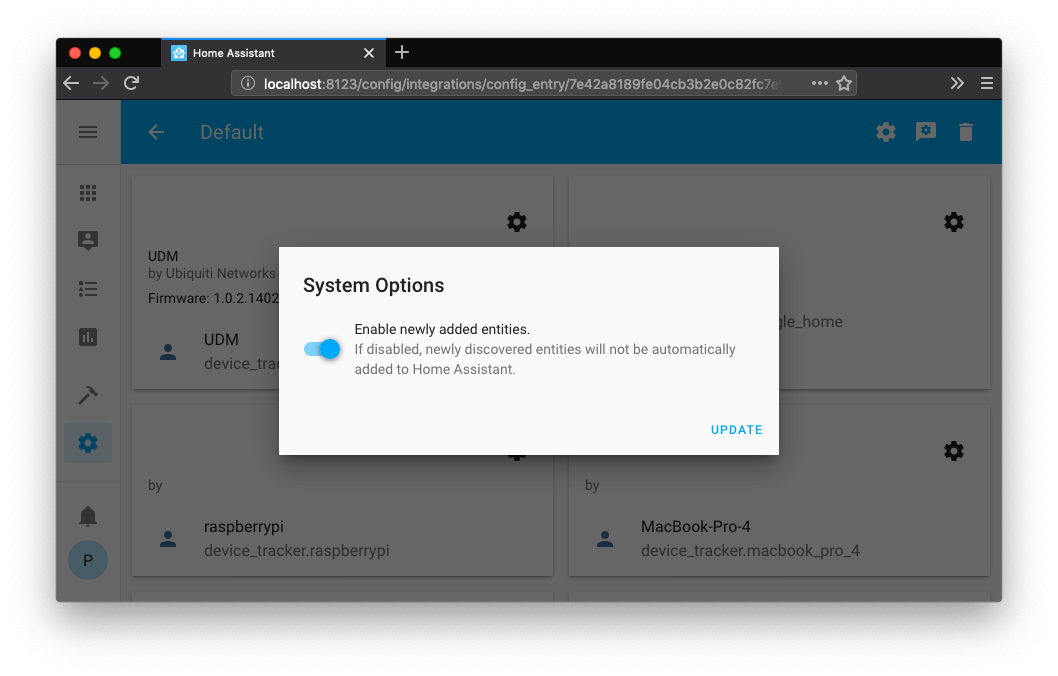 Screenshot of integration system options
Screenshot of integration system options
Config Entry Options
We introduced config entries last year as our way as a generic way for integrations to store authentication and configuration. By allowing integrations to define the storage format, there are no more backward-incompatible changes for anything stored inside config entries!
Config entries also work great with people who prefer configuration.yaml. At startup a config entry is created/updated with the configuration.
With this release @kane610
This release adds config entry options to Deconz and Unifi integrations with many more to come.
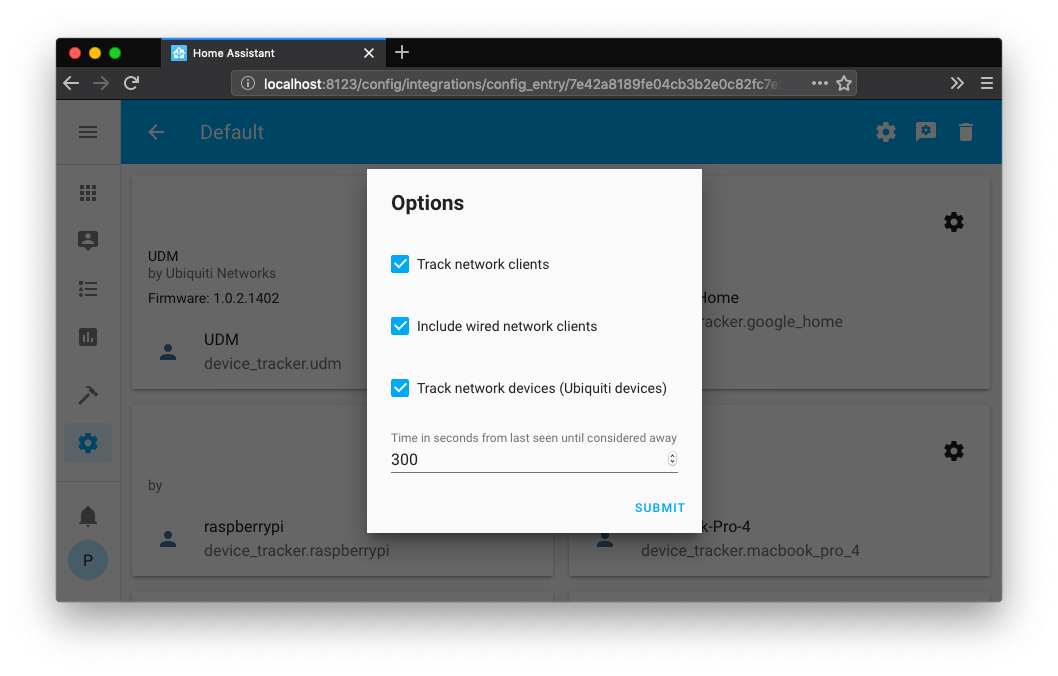 Screenshot of Unifi config options
Screenshot of Unifi config options
Home Assistant Alerts
Devices and services can receive updates that can cause integrations to break. This is frustrating and sometimes the cause can be hard to track down. Usually the users on forums/chat are aware and can help redirect people in the right direction, but that’s not a scalable solution!
So to combat this, we’re launching Home Assistant Alerts. Home Assistant Alerts is a website that will track known issues and explains in user friendly language what is going on. Alerts can be tagged with applicable Home Assistant versions, integrations and Python packages.
In the future we’re planning on integrating this directly in Home Assistant, so that users can be pro-actively notified of issue related to their configuration.
Docker base image change
If you run Home Assistant via Docker (not Hass.io) and are using the homeassistant/home-assistant container, the images are now using the same images as hass.io, which are using Alpine Linux instead of Debian.
The hass.io images are a third of the size of the old images and are heavily optimized thanks to the hard work by @pvizeli
This change will only impact you if you were extending or customizing the image with Debian packages. If you want to continue to use the Debian based images, you can find the Dockerfile for the old images here
For more background on this decision, see ADR-006
Webscraping
With this release we have deprecated integrations that rely on webscraping. These will be removed from Home Assistant in a future release. Our scrape integration will remain part of Home Assistant.
Webscraping is fragile, breaks often requires frequent updates and there have been occasions where websites have banned our users.
Users that rely on these integrations can continue using them as custom components.
For more background on this decision, see ADR-004
In Other News
Mason Made
Reddit user Skyfox2k

New Integrations
- Add Plugwise component (@CoMPaTech
- #25533 ) (plugwise docs) (new-integration) - GeoNet NZ Quakes feed integration (@exxamalte
- #25736 ) (geonetnz_quakes docs) (new-integration) - Add Keba charging station/wallbox as component (@dannerph
- #24484 ) (keba docs) (new-integration) - Add Minio component (@tkislan
- #23567 ) (minio docs) (new-integration)
New Platforms
- Add ring switch platform (@rossdargan
- #25612 ) (ring docs) (new-platform) - Add ring light platform (@rossdargan
- #25733 ) (ring docs) (new-platform) - Expose Lutron RA2 occupancy sensors (@achatham
- #25854 ) (lutron docs) (new-platform)
Release 0.98.1 - August 29
- Update sensor.py (@eliseomartelli
- #26209 ) (qbittorrent docs) - Fix for 0.98: Don’t update disabled entities (Homematic IP Cloud) (@SukramJ
- #26236 ) (homematicip_cloud docs) - Fix ZHA state restore by always restoring last seen on devices (@dmulcahey
- #26271 ) (zha docs) - Fix missing DarkSky mdi icon (@mbo18
- #26274 ) (darksky docs) - Fix partly cloudy (@balloob
- #26277 ) (buienradar docs) (mysensors docs) - UniFi - dont schedule updates on disabled entities (@Kane610
- #26278 ) (unifi docs)
Release 0.98.2 - September 2
- Expose current direction properly on state machine (@balloob
- #26298 ) (demo docs) (fan docs) - bump tuyaha 0.0.4 (@PaulAnnekov
- #26303 ) (tuya docs) - Fix Alexa Report State (@balloob
- #26305 ) (alexa docs) (cloud docs) - Fix alexa bad temp sensors (@balloob
- #26307 ) (alexa docs) - Fix google_maps scan interval (@tyjtyj
- #26328 ) (google_maps docs)
Release 0.98.3 - September 4
- Upgrade pyhaversion to 3.1.0 (@fabaff
- #26232 ) (version docs) - String has nothing to do with class method naming (@Kane610
- #26368 ) (deconz docs) - Fix race during initial Sonos group construction (@amelchio
- #26371 ) (sonos docs) - Allow core config updated (@balloob
- #26398 ) (websocket_api docs) - Met, check for existing location (@Danielhiversen
- #26400 ) (met docs) - Update Harmony to 0.1.13 (@ehendrix23
- #26402 ) (harmony docs) - Fix state report (@balloob
- #26406 ) (alexa docs) - Bump ISY994’s PyISY dependency to 1.1.2 (@OverloadUT
- #26413 ) (isy994 docs)
Release 0.98.4 - September 4
- Fix Tuya switches (@balloob
)
Release 0.98.5 - September 6
We have been notified by Gregor Godbersen that our markdown renderer was vulnerable for an XSS attack if exposed to specially crafted markdown. This was introduced in the Home Assistant 0.98 release. We have verified that Home Assistant 0.98.0 does not render unsafe markdown, yet still wanted to make sure to issue an update as soon as possible.
More information in this frontend pull request
If you need help…
…don’t hesitate to use our very active forums or join us for a little chat
Reporting Issues
Experiencing issues introduced by this release? Please report them in our issue tracker
0.97: Apache Kafka, Fortigate, Twente Milieu
It’s time for Home Assistant 0.97! It has been a very busy release cycle as we have been fine-tuning our development process, which makes it easier to maintain and contribute to Home Assistant in the future.
Python 3.5 support has been dropped
As per previous announcements, this is the first release that requires at least Python 3.6. If you are on Hassbian and are planning to upgrade Python, please take note of the known issues with the default wheel server.
Docker
This is the last release that bases our Home Assistant Docker image (homeassistant/home-assistant) on Debian. As decided in Architecture Decision Record 0006: Docker Images
The main driver behind this change is that by re-using images, maintenance becomes easier, and users of the homeassistant/home-assistant image can benefit from the many optimizations that went into the Hass.io images.
Reload scenes from configuration.yaml
Thanks to @balloobconfiguration.yaml without restarting Home Assistant. This is part of an effort for Home Assistant 1.0 to make scenes a first-class citizen of Home Assistant, including creating/restoring scenes on the fly in the future. To track this effort, follow this page
Home Assistant Cast
In case you missed the announcement, we released Home Assistant Cast yesterday. It allows you to transform any Cast interface into a display for Home Assistant. Read the announcement for more information..
Home Assistant Cast opens a whole new world of possibilities for using Lovelace, and we are really excited to learn what cool things you will do with it! If you created something, feel free to share it on social media using the #homeassistantcast hash-tag. We are looking forward to your pictures!
UI changes
This release contains a couple of notable UI changes:
- New Cast row available in the Lovelace entities card to start Home Assistant Cast.
- Improved accessibility for visually impaired users. This is an ongoing effort
on making the frontend accessible. - Split out
configuration.yamlactions from the core configuration into a new server control config panel. Thanks @IcyPalm - Markdown card now has a size + 1, if it has a header defined. Some layouts might be moved around due to this.
In other news
Frenck
Aaron
We wrote about how we use Azure DevOps to automate the development of Home Assistant. Interested to see how Home Assistant is automatically build? Check the developer blog.
@jimz011
New Integrations
- Add support for recording history to Apache Kafka (@bachya
- #25085 ) (apache_kafka docs) (new-integration) - Rename RitAssist to FleetGO (@depl0y
- #25093 ) (fleetgo docs) (ritassist docs) (breaking change) (new-integration) - Add Twente Milieu integration (@frenck
- #25129 ) (twentemilieu docs) (new-integration) - Add Fortigate integration (@kifeo
- #24908 ) (new-integration) - Add support for Rainforest Eagle-200 (@gtdiehl
- #24919 ) (rainforest_eagle docs) (new-integration) - Add Elgato Avea integration (@pattyland
- #24281 ) (avea docs) (new-integration) (new-platform) - Suez water (@ooii
- #23844 ) (suez_water docs) (new-integration) - Add new device tracker supporting Fortinet FortiGate (@kimfrellsen
- #23078 ) (fortios docs) (new-integration) (new-platform) - Add De Lijn (Flemish Public Transport) component (@bollewolle
- #24265 ) (delijn docs) (new-integration) (new-platform) - Add Support for VeSync Devices - Outlets and Switches (@webdjoe
- #24953 ) (vesync docs) (new-platform)
Release 0.97.1 - August 9
A new breaking change was introduced with 0.97.1 to accommodate for the HaveIBeenPwned shutting down v2 of their API on August 18. The integration has been migrated to using v3.
- Update HIBP sensor to use API v3 and API Key (@aetaric
- #25699 ) (haveibeenpwned docs) (breaking change) - Update Cisco Mobility Express module version (@fbradyirl
- #25770 ) (cisco_mobility_express docs) - Don’t track unstable attributes (@jjlawren
- #25787 ) (unifi docs) (breaking change) - Fix deconz allow_clip_sensor and allow_deconz_groups options (@Anonym-tsk
- #25811 ) (deconz docs)
Release 0.97.2 - August 11
- Fix eco preset for Wink Air Conditioner (@cameronrmorris
- #25763 ) (wink docs) - Update pyvera to 0.3.3 (@brandond
- #25820 ) (vera docs) - Fix Netatmo climate issue (@cgtobi
- #25830 ) (netatmo docs) - Fix KNX Climate mode change callback (@tombbo
- #25851 ) (knx docs) - Always populate hvac_modes in SmartThings climate platform (@andrewsayre
- #25859 ) (smartthings docs) - UniFi - Use state to know if device is online (@Kane610
- #25876 ) (unifi docs) - Fix issue with nuki new available state (@pvizeli
- #25881 ) (nuki docs)
If you need help…
…don’t hesitate to use our very active forums or join us for a little chat
Reporting Issues
Experiencing issues introduced by this release? Please report them in our issue tracker
Home Assistant Cast

Home automation itself has never been a goal of Home Assistant. Instead, it’s a tool that allows us to have technology improve our life, and that of the people around us. I wrote about this 3,5 years ago, and it’s been our guiding principle in building out Home Assistant.
Today we’re introducing Home Assistant Cast to help with this. With Home Assistant Cast, people in your house can have quick access to see the state of your house and its residents, and quickly adjust the most important settings. This is achieved by running on Chromecast powered screens that you already have throughout your house: your Google Nest Hubs and TVs.
You can launch Home Assistant Cast by going to the Home Assistant Cast launcher website. It works with any version of Home Assistant released in the last year. Home Assistant Cast can show any Lovelace view, including support for custom cards and themes. Got no Lovelace configuration? Don’t worry, we’ll generate a view and show that instead.
For a demo, also check out the Home Assistant Cast launcher. If you have any questions, make sure to check the Frequently Asked Questions.
How it works
You need to authorize Home Assistant Cast to access your Home Assistant instance. Once it’s authorized, you can start Home Assistant Cast on your Chromecast device. Next, your Chromecast device will set up a direct connection to your Home Assistant instance and give you the option to pick a view to display.
Home Assistant Cast can:
- Render Lovelace views, including custom cards.
- Stream real-time data to make sure that the UI always shows the latest state of your house.
- Navigate between views using navigate actions inside an entities card or using weblinks.
- Instantly update the casted Lovelace UI when you update your Lovelace configuration.
About touch
We have been able to get touch controls working on the Google Nest Hub and other Google Assistant devices with a screen. The available configuration options to indicate that we’re a touch-optimized app did not work
There is no guarantee that touch controls will keep working, it might be blocked. It might stop this week, next month, next year, or it keeps working forever.
I hope that by releasing it with touch controls enabled, we can show Google that this is something that people want, and are willing to invest in for just this reason.
To make sure everyone sees it, I encourage people to share photos and videos of Home Assistant Cast in action on Twitter, Facebook, YouTube and other social media with the hashtag #homeassistantcast. Let’s share the love!
Coming soon and future plans
On August 7, Home Assistant 0.97 will be released. This release will allow launching Home Assistant Cast from the Home Assistant frontend. You can do this by including a new cast row that can be placed inside an entities card.
# Example entities card configuration
type: entities
entities:
- type: cast
name: Lights
# The path of the view (or number)
view: lights
hide_if_unavailable: true
This is the first release of Home Assistant Cast, and so we focused on the minimum that was worthy of a release. We still have some more things planned:
- Allow starting Home Assistant Cast from Home Assistant itself (not a browser), as part of an automation or script. This is live now since Home Assistant 0.99.
- Use Home Assistant Cast as a text-to-speech target (inspired by lovelace-browser-commander by @thomasloven
).




